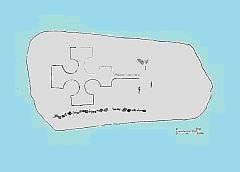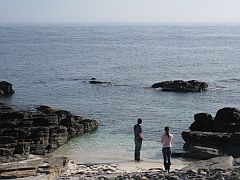|
Burrian Broch
The broch is thought to date from the first or second
centuries BC although there is some evidence of earlier
habitation.
Visitors to Howar can walk past the herd of alpacas
who often expect visitors to have food for them. Don't offer them
any treats, if you wish, June or Gerry will give
you and handful of their special food.
 Continue to the tide roosts beyond the small gate to
the shore. As the tide comes in so the fishing machines that are the
cormorant and shag gather on rocky out-crops
above the waves. Approach the gateway slowly and not too close and
watch cormorants doing their "cormorant
thing" with wings outstretched. Continue to the tide roosts beyond the small gate to
the shore. As the tide comes in so the fishing machines that are the
cormorant and shag gather on rocky out-crops
above the waves. Approach the gateway slowly and not too close and
watch cormorants doing their "cormorant
thing" with wings outstretched.
Just
before the last gateway to the broch look over the sea dyke
for seals sunbathing on the rocks. Towards evening more and more seals haul out onto the slabs of rock around
the broch to catch the last rays of the sun.
On the approaches to the broch see if you can make
out the lines of the the four defensive ditches. There were probably
a number of Celtic dwellings beyond the
broch. A geophysics survey, in 2005, by Orkney College Geophysics
Unit identified the remains of structures
outside the ramparts. The survey extended to the site of the
medieval farmstead of Burrigar, east of the
broch, where more structural anomalies were located.
 Inside the broch there is what was described as
a well or chamber by the 1870 Trail excavation. Comparison with
Minehowe might suggest that it was the beginning
of stairs to a series of underground chambers. What do you think? On
the right as you face away from the sea is
the remains of a storage cist. A mixture of ash and grain were found
here in
1870, possibly a way of
preserving food. Inside the broch there is what was described as
a well or chamber by the 1870 Trail excavation. Comparison with
Minehowe might suggest that it was the beginning
of stairs to a series of underground chambers. What do you think? On
the right as you face away from the sea is
the remains of a storage cist. A mixture of ash and grain were found
here in
1870, possibly a way of
preserving food.
The most
significant find in 1870 was a stone slab 686mm long engraved  with a cross and Ogham script. The Burrian Cross has
since become
one of the symbols of Orkney. It is now displayed in the
National Museum of Scotland.
with a cross and Ogham script. The Burrian Cross has
since become
one of the symbols of Orkney. It is now displayed in the
National Museum of Scotland.
Did the inhabitants of the broch speak Welsh? The
Pictish Ogham script has yet to be satisfactorily translated
although there have been several attempts.
Current thinking is that the language spoken by the Picts, was a
form of British similar to P-Celtic Welsh rather
than Q-Celtic Irish. Evidenced by Irish speaking Columba taking a
translator to communicate with the Picts.
 The original entrance was from the shore. Perhaps
the best perspective of the broch is gained from the shore. I like
to sit on the rocky slabs and contemplate what
it must have been like when the peace of the island was broken by
the arrival of the Vikings around 800AD. The
culture of the Picts was eradicated from North Ronaldsay with
perhaps one or two place names having Celtic roots. The original entrance was from the shore. Perhaps
the best perspective of the broch is gained from the shore. I like
to sit on the rocky slabs and contemplate what
it must have been like when the peace of the island was broken by
the arrival of the Vikings around 800AD. The
culture of the Picts was eradicated from North Ronaldsay with
perhaps one or two place names having Celtic roots.
 Do not be tempted to climb over the sea dyke. The
inevitable loosening of the stones will allow the sheep to invade
the island and the islanders will be very angry.
Retrace your steps a little way to the gateway to the shore and walk
along the shore back to the broch. You will be
rewarded by pretty little rocky bays and to your left the burnt
layers of an exposed iron age midden. Do not
poke into it. You may destroy evidence of iron age life. Do not be tempted to climb over the sea dyke. The
inevitable loosening of the stones will allow the sheep to invade
the island and the islanders will be very angry.
Retrace your steps a little way to the gateway to the shore and walk
along the shore back to the broch. You will be
rewarded by pretty little rocky bays and to your left the burnt
layers of an exposed iron age midden. Do not
poke into it. You may destroy evidence of iron age life.
|  Continue to the tide roosts beyond the small gate to
the shore. As the tide comes in so the fishing machines that are the
cormorant and shag gather on rocky out-crops
above the waves. Approach the gateway slowly and not too close and
watch cormorants doing their "cormorant
thing" with wings outstretched.
Continue to the tide roosts beyond the small gate to
the shore. As the tide comes in so the fishing machines that are the
cormorant and shag gather on rocky out-crops
above the waves. Approach the gateway slowly and not too close and
watch cormorants doing their "cormorant
thing" with wings outstretched.  Inside the broch there is what was described as
a well or chamber by the 1870 Trail excavation. Comparison with
Minehowe might suggest that it was the beginning
of stairs to a series of underground chambers. What do you think? On
the right as you face away from the sea is
the remains of a storage cist. A mixture of ash and grain were found
here in
1870, possibly a way of
preserving food.
Inside the broch there is what was described as
a well or chamber by the 1870 Trail excavation. Comparison with
Minehowe might suggest that it was the beginning
of stairs to a series of underground chambers. What do you think? On
the right as you face away from the sea is
the remains of a storage cist. A mixture of ash and grain were found
here in
1870, possibly a way of
preserving food.  with a cross and Ogham script. The Burrian Cross has
since become
one of the symbols of Orkney. It is now displayed in the
National Museum of Scotland.
with a cross and Ogham script. The Burrian Cross has
since become
one of the symbols of Orkney. It is now displayed in the
National Museum of Scotland.  The original entrance was from the shore. Perhaps
the best perspective of the broch is gained from the shore. I like
to sit on the rocky slabs and contemplate what
it must have been like when the peace of the island was broken by
the arrival of the Vikings around 800AD. The
culture of the Picts was eradicated from North Ronaldsay with
perhaps one or two place names having Celtic roots.
The original entrance was from the shore. Perhaps
the best perspective of the broch is gained from the shore. I like
to sit on the rocky slabs and contemplate what
it must have been like when the peace of the island was broken by
the arrival of the Vikings around 800AD. The
culture of the Picts was eradicated from North Ronaldsay with
perhaps one or two place names having Celtic roots.  Do not be tempted to climb over the sea dyke. The
inevitable loosening of the stones will allow the sheep to invade
the island and the islanders will be very angry.
Retrace your steps a little way to the gateway to the shore and walk
along the shore back to the broch. You will be
rewarded by pretty little rocky bays and to your left the burnt
layers of an exposed iron age midden. Do not
poke into it. You may destroy evidence of iron age life.
Do not be tempted to climb over the sea dyke. The
inevitable loosening of the stones will allow the sheep to invade
the island and the islanders will be very angry.
Retrace your steps a little way to the gateway to the shore and walk
along the shore back to the broch. You will be
rewarded by pretty little rocky bays and to your left the burnt
layers of an exposed iron age midden. Do not
poke into it. You may destroy evidence of iron age life.